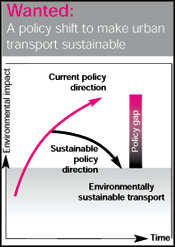Comprehend
 A ccording to the World Bankif gdp grows at 7-8 per cent a year over the next decadethe demand for transport will grow by at least 10 per cent a year. The worsening traffic situation and increasing travel demand has compelled a number of cities to at least put up a semblance of a transport plan (see box: Many plansno vision). Noble ideas. Yet all these plans may not achieve what they wish to. The problems remain: institutional weaknessmultiple authority and unclear policy direction as to what is desirable and how to achieve that.
A ccording to the World Bankif gdp grows at 7-8 per cent a year over the next decadethe demand for transport will grow by at least 10 per cent a year. The worsening traffic situation and increasing travel demand has compelled a number of cities to at least put up a semblance of a transport plan (see box: Many plansno vision). Noble ideas. Yet all these plans may not achieve what they wish to. The problems remain: institutional weaknessmultiple authority and unclear policy direction as to what is desirable and how to achieve that.
One of the prerequisites of good transport management is a reliable database of on-road vehicles. Almost all state transport departments lack confirmed information about the real number of vehicles on their roads. The usual practice is to add the new registered vehicles to the existing numbers. Thereforeinstead of giving the actual number of vehicles on roadany registration data in fact gives the cumulative number of vehicles registered till that date. It does not take into account vehicles that have gone off the road. This weakens the promises made in most transport plans.
Most plans also promise a modal shift from private to publiccrucial to reverse the trend of motorisation. Yet none are able to provide plausible proof of their otherwise grandiose intent. "The issue is not what we are setting out to do. The issue is to set out in one place what the vision and the road map is' says Sindhushree Khullarcommissioner (transport)Government of National Capital Territory of Delhi. "When people will jump off their motor and get into the metroI am not sure. But the issue is when all these are in place nobody can then say that public transport is inconvenient. The issue is to create options' she points out.
These plans are strong on providing options to the commutersbut there is yet no disincentive for private vehicles. Khullar agrees that people must pay the social cost of operating personalised transportalthough the economic and fiscal measures still need to be worked out. Yet she is cynical: "You can make all the conditions conducive to the shift. But whether that shift will occur or notI cannot tell.'"[The Delhi transport plan] is not a transportation plan. It is a scheme that they are trying to do' says T S Reddyarea coordinatorTraffic and Transportation PlanningCentral Road Research Institute. "A plan should have clearly defined objectives translated into goalswhich are quantifiable. A simple mass transport may not be able to help. And simply leaving mass transport to the winds is also not going to be in the interest of the society at large. That is precisely what has happened in Delhi' he points out. This is true of most transport plans.
"There appears to be no political will to expedite such projects. We have been suggesting to the government to set a Metropolitan Transport Authority (in Hyderabad)both rail and bus transport networks with a single ticket. A safefast and reliable public transport system is the only answer to reduce the vehicle load on the roads' says Capt J Rama Raochairperson of
Related Content
- A synthesis report: carbon pricing approaches in West Africa
- Understanding investment, trade, and battery waste management linkages for a globally competitive EV manufacturing sector
- State of India’s environment 2022: in figures
- Global drivers of food system (un)sustainability: A multi-country correlation analysis
- 2019 Global Go To Think Tank Index Report
- Country report – Republic of South Africa: regulating water and urban sanitation
